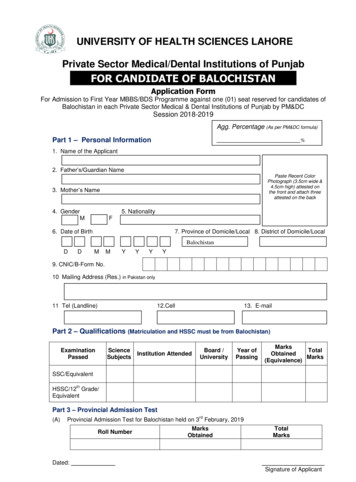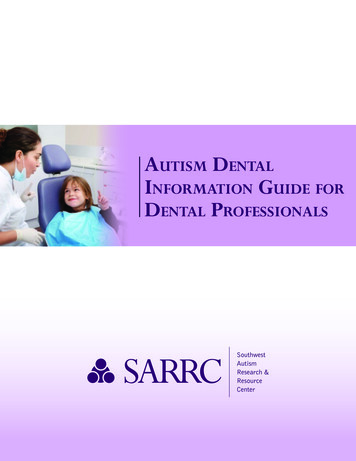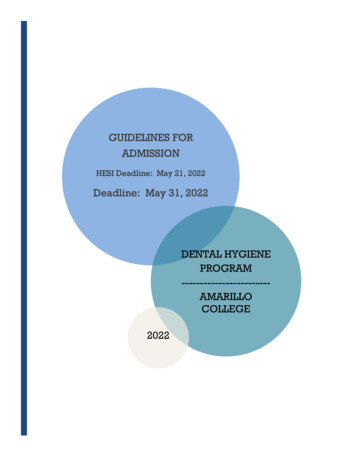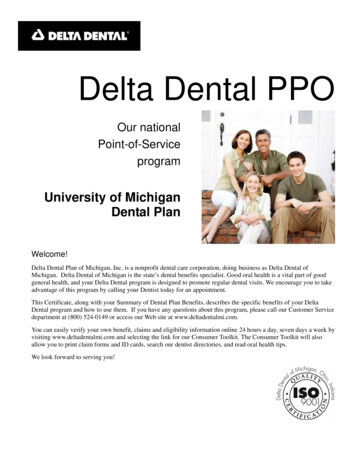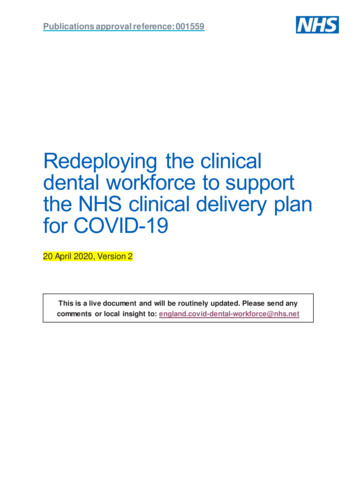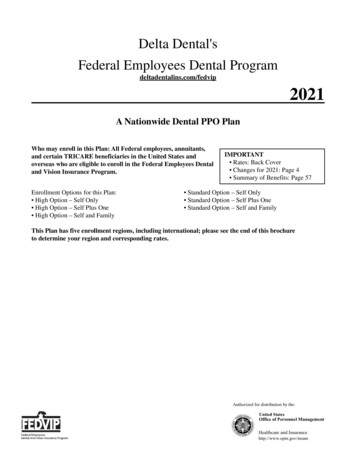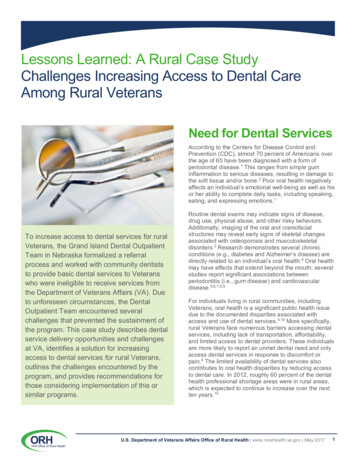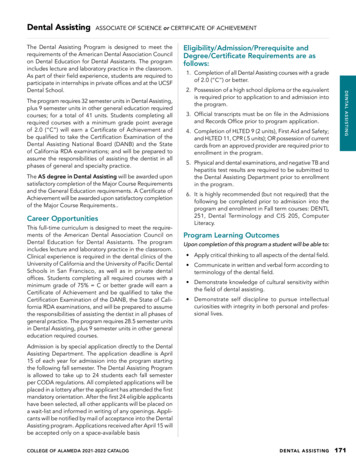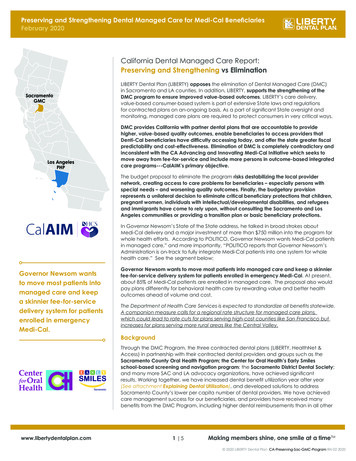
Transcription
Preserving and Strengthening Dental Managed Care for Medi-Cal BeneficiariesFebruary 2020California Dental Managed Care Report:Preserving and Strengthening vs EliminationSacramentoGMCLos AngelesPHPLIBERTY Dental Plan (LIBERTY) opposes the elimination of Dental Managed Care (DMC)in Sacramento and LA counties. In addition, LIBERTY, supports the strengthening of theDMC program to ensure improved value-based outcomes. LIBERTY’s care delivery,value-based consumer-based system is part of extensive State laws and regulationsfor contracted plans on an-ongoing basis. As a part of significant State oversight andmonitoring, managed care plans are required to protect consumers in very critical ways.DMC provides California with partner dental plans that are accountable to providehigher, value-based quality outcomes, enable beneficiaries to access providers thatDenti-Cal beneficiaries have difficulty accessing today, and offer the state greater fiscalpredictability and cost-effectiveness. Elimination of DMC is completely contradictory andinconsistent with the CA Advancing and Innovating Medi-Cal Initiative which seeks tomove away from fee-for-service and include more persons in outcome-based integratedcare programs---CalAIM’s primary objective.The budget proposal to eliminate the program risks destabilizing the local providernetwork, creating access to care problems for beneficiaries – especially persons withspecial needs – and worsening quality outcomes. Finally, the budgetary provisionrepresents a unilateral decision to eliminate critical beneficiary protections that children,pregnant women, individuals with intellectual/developmental disabilities, and refugeesand immigrants have come to rely upon, without consulting the Sacramento and LosAngeles communities or providing a transition plan or basic beneficiary protections.In Governor Newsom’s State of the State address, he talked in broad strokes aboutMedi-Cal delivery and a major investment of more than 750 million into the program forwhole health efforts. According to POLITICO, Governor Newsom wants Medi-Cal patientsin managed care,” and more importantly, “POLITICO reports that Governor Newsom’sAdministration is on-track to fully integrate Medi-Cal patients into one system for wholehealth care.” See the segment below:Governor Newsom wantsto move most patients intomanaged care and keepa skinnier fee-for-servicedelivery system for patientsenrolled in emergencyMedi-Cal.Governor Newsom wants to move most patients into managed care and keep a skinnierfee-for-service delivery system for patients enrolled in emergency Medi-Cal. At present,about 85% of Medi-Cal patients are enrolled in managed care. The proposal also wouldpay plans differently for behavioral health care by rewarding value and better healthoutcomes ahead of volume and cost.The Department of Health Care Services is expected to standardize all benefits statewide.A companion measure calls for a regional rate structure for managed care plans,which could lead to rate cuts for plans serving high-cost counties like San Francisco butincreases for plans serving more rural areas like the Central Valley.BackgroundThrough the DMC Program, the three contracted dental plans (LIBERTY, HealthNet &Access) in partnership with their contracted dental providers and groups such as theSacramento County Oral Health Program; the Center for Oral Health’s Early Smilesschool-based screening and navigation program; the Sacramento District Dental Society;and many more SAC and LA advocacy organizations, have achieved significantresults. Working together, we have increased dental benefit utilization year after year(See attachment Explaining Dental Utilization), and developed solutions to addressSacramento County’s lower per capita number of dental providers. We have achievedcare management success for our beneficiaries, and providers have received manybenefits from the DMC Program, including higher dental reimbursements than in all otherwww.libertydentalplan.com1 5Making members shine, one smile at a timeTM 2020 LIBERTY Dental Plan CA-Preserving-Sac-GMC-Program RN 02 2020
Preserving and Strengthening Dental Managed Care for Medi-Cal BeneficiariesFebruary 2020CA counties. These efforts were recognized by First 5 Sacramento in 2019, who awardedthe 3 DMC plans their High 5 award for their efforts in improving the lives of children andfamilies through sustainable funding for children’s dental services, including the “EarlySmiles” program.SacramentoGMCLos AngelesPHPImproved Utilization & Access to Care: Why Sacramento was originally provided DentalManaged Care: Sacramento County has fewer dentists per capita than the rest ofCalifornia (1:1325 in Sacramento, compared to 1:1200 statewide according to CountyHealth Rankings). Despite this, the DMC Program has grown the provider networkand utilization has steadily improved because the plans have gotten more dentists toparticipate in the DMC Program. Approximately 33.8% of practicing dentists in SacramentoCounty participate in DMC, which is almost twice the rate statewide (15.4% accordingto the American Dental Association). The dental plans pay higher rates to ensure accessto care and help dentists navigate requirements and support their ongoing retention;according to the SDDS, elimination of DMC may result in a significant number of providerschoosing not to participate in Denti-Cal. Link: lder-Communication-Feb2020.pdfLos Angeles County PHP is a voluntary program in which beneficiaries are automaticallydefaulted into Denti-Cal FFS program unless that make a deliberate choice to pick aDMC plan. As a result, the enrollment has been static and approximately 10% of theeligible population. In order to expand awareness, in just 2019, LIBERTY has activelycontributed and participated in approximately 125 outreach activities including backto-school events and pre-natal workshops for women utilizing Medi-Cal and emergencyMedi-Cal in several different languages.According to the DHCS report issued in Oct/2019 (link below): Total reimbursement todentists increased by 28.6% but dentist participation actually decreased by 2.3%!A Few Report Key Findings: Medi-Cal average payments versus other comparable states’ Medicaid Program’sdental fee schedules increased an average of 20.1 percent between SFY 2016-17and SFY 2017-18. This increase is largely due to additional Prop 56 supplementalpayments. Medi-Cal average payments versus regional commercial rates increased an averageof 3.8 percent between SFY 2016-17 and SFY 2017-18. This increase is largely dueto additional Proposition 56 (Prop 56) supplemental payments. See Appendix 4 andAppendix 5a, respectively. Medi-Cal’s total service count increased 9.2 percent between SFY 2016-17 andSFY 201718, while the total reimbursement increased 28.6 percent. See Appendix6a, Appendix 6b, Appendix 7a, and Appendix 7b, respectively.NCQA is considering retiringthe ADV as a measure. Medi-Cal’s FFS total beneficiary population with at least three months of continuouseligibility decreased 1.8 percent between SFY 2016-17 and SFY 2017-18. See Appendix9a and Appendix 10a, respectively. Medi-Cal dental FFS provider enrollment data shows the number of enrolled activeservice offices increased by 4.7 percent and rendering providers decreased by 2.3percent between SFY 2016-17 and SFY 2017-18. See Appendix 11.Utilization Comparisons: A Special Interest Argument to Eliminate DentalManaged CareBefore we demonstrate why utilization comparisons are invalid, it is important toNOTE that the NCQA, the national premier organization in terms of measuring qualityperformance in managed care, is officially opining that Annual Dental Visit (ADV) is not agood quality performance measure and is considering retiring the ADV as a measure. Inwww.libertydentalplan.com2 5Making members shine, one smile at a timeTM 2020 LIBERTY Dental Plan CA-Preserving-Sac-GMC-Program RN 02 2020
Preserving and Strengthening Dental Managed Care for Medi-Cal BeneficiariesFebruary 2020SacramentoGMCCA, they have begun to focus on CMS-416 reporting rather than HEDIS, however, the onlydifference between HEDIS ADV and CMS 416 “Any Dental Service”, is that CMS-416 uses90 day eligibility vs. 11 0f 12 months for HEDIS: and, CMS-416 includes 2 year olds. Theybasically measure the same thing. The principal evidence used by the State DHCS toeliminate DMC is the lower ADV score. Now, the premier and highly respected nationalquality organization is saying that ADV is not a good measure to use. We once againpoint out that there are other important elements other than ADV to look at in terms ofevaluating the DMC program. Link: omments/hedis-public-comment/Below are summarized Four Key Points that demonstrate with factual data, that utilizationProgram comparisons are invalid:Los AngelesPHP1. The Denti-Cal Fee-For-Service Program, administered by Delta Dental for the State, is aFiscal Intermediary and Administrative Services Program for 56 counties vs. acontracted managed care program for Sacramento County on a mandatory basisand Los Angeles County on a voluntary basis. The Denti-Cal Program is fundamentallyepisodic and emergent vs. a preventative and diagnostic program administered bythe dental managed care plans. See attached explaining Program Differences.2. The Denti-Cal Program’s Utilization numbers include any qualified healthcarepractitioner providing dental services---example being a pediatrician in a medicaloffice. Dental managed care may only include dentists and/or dental hygienists. In2018, 9.9% of these services was reported for Denti-Cal Utilization. If you back outthe non-dental provider services, the dental managed care utilization IS ACTUALLYHIGHER! See attachment Comparing Utilization. Please note the periodicity schedule for CHDP in the link below. Physicians can billMedi-Cal for dental health assessments multiple times and sometimes multiple timesin the same year. This practice is not prohibited by NCQA/HEDIS or CMS. However,it is not valid to use the ADV-HEDIS to assess the effectiveness of the DMC programin comparison to Denti-Cal FFS if our networks are limited to Dental Practitioners.The ADV-HEDIS measure would only be a fair one if medical encounter data wereexcluded from Denti-Cal FFS. Example: Child Health and Disability PreventionProgram (CHDP), and the main source of medical encounter data that DHCS hasbeen using. See link below. Using medical data from CHDP or Child Well Visits would haveto be reported as Diagnostic or Preventive category of services. Hence, exaggeratingthe PDENT score and making Denti-Cal’s PDENT score an unreasonable way tocompare FFS to DMC.Link: s/Masters-Other/CHDP/forms/periodhealth c01.pdf DEFINITIONS: ADV is any service regardless of being preventive, restorative,palliative, etc., received within 12 months and counted once, in which the medicaldata was indeed included. PDENT is any preventive services, which could be someor most of the services performed by medical practitioners (Fluoride treatment, etc.)thereby exaggerating Denti-Cal’s volume of preventive services. The only way tosee the real numbers is to get the medical data subtracted from dental data.3. The State DHCS reports CMS 416 data to the Feds UT numbers on a statewide averagebasis which is to say they lump together 56 of 58 counties for the Denti-Cal Fee-ForService Program. The dental managed care plans report for Sacramento and LosAngeles counties individually. See attached Comparison Map that shows State’sactual county by county data and then LIBERTY’s UT for each county. Seeing scoresin a regional context paint a completely different picture.4. Comparisons also ignore fundamental differences in program requirements whichwww.libertydentalplan.com3 5Making members shine, one smile at a timeTM 2020 LIBERTY Dental Plan CA-Preserving-Sac-GMC-Program RN 02 2020
Preserving and Strengthening Dental Managed Care for Medi-Cal BeneficiariesFebruary 2020directly affect utilization such as the requirement for the plans to administer acomprehensive fraud, waste, and abuse (FWA) Program Integrity plan. The FederalOffice of the Inspector General’s 2016 Report on CA Medi-Cal Children estimates FWAaccounts for as much as 25% of the utilization totals.We argue that the important questions are: How do we measure healthier outcomesthat could convert to utilization? What is a reasonable utilization for SAC GMC and/orwhat should it be? See attachment Explaining Dental Utilization which demonstratesLIBERTY Dental Plan’s year over year improvements.SacramentoGMCDMC Program BenefitsLos AngelesPHP Under DMC, beneficiaries have guaranteed access to dental care. The dental plansmust contract with enough providers to meet beneficiary needs and if an in-networkdentist cannot be located, the plans must locate another provider to ensure eachbeneficiary is served. No such requirement exists under the Denti-Cal Program. Manyareas of the state do not have sufficient participating providers. According to a 2014State Auditor’s Report, 11 of 58 counties have no Denti-Cal providers. The DMC plans perform ongoing care management/coordination and navigation forbeneficiaries and help them access dental specialists through the specialty referralprocess. This support is critical for beneficiaries with special needs and othervulnerable populations such as foster children. DMC plan case managers alsonavigate folks, perhaps homeless, to appropriate social services. Under Denti-Cal, theburdens of system navigation and locating a provider who is accepting new patients fallon beneficiaries, which can create barriers to care and worsen oral health outcomes. The dental plans are engaged community partners who provide oral healtheducation and support for many local organizations. Through wellness and outreachprograms, the plans support health fairs and community events reaching thousandsof low-income families and have developed innovative initiatives such as the EarlySmiles program, which has served approaching 27,000 mostly DMC-eligible children in60 schools, across 6 school districts in Sacramento County, since 2016. These valuablecommunity programs would be eliminated with the DMC Program’s elimination. Seeattached Early Smiles Report.Under DMC, beneficiarieshave guaranteed access todental care.E A R L YSMILESSacramentoA Center for Oral Health Programwww.libertydentalplan.com DMC plans and contracted providers are subject to extensive licensure andregulatory requirements and ongoing oversight by the DMHC and DHCS to ensureaccess to care, quality of care, and financial solvency. FFS providers are not subjectto these requirements. The dental plans are accountable for the quality of care provided by networkdentists and manage their networks. Using financial incentives, provider education,and quality improvement projects, the plans have elevated the quality of care inSacramento, reinforced the importance of preventive dentistry, and supportedthe dental home model. Under Denti-Cal, while the state contracts with all willingproviders, there are no efforts to change provider practice patterns or improve caredelivery.Cost EffectivenessHistorically, DMC rates were set to equal 97.5% of the applicable FFS costs. The LA PHPclaims cost included in the PHP DMC rate was equivalent to 97.5% of the LA Denti-CalFFS claims cost. Because there is no significant Denti-Cal FFS enrollment in Sacramento,Fresno was considered to be a close proxy, therefore the Sacramento GMC claims costincluded in the GMC DMC rate was equivalent to 97.5% of the Fresno Denti-Cal FFS4 5Making members shine, one smile at a timeTM 2020 LIBERTY Dental Plan CA-Preserving-Sac-GMC-Program RN 02 2020
Preserving and Strengthening Dental Managed Care for Medi-Cal BeneficiariesFebruary 2020claims cost. In determining the DMC rates, the FFS claims costs were reduced by 2.5% toprovide for the anticipated savings generated by the higher level of care managementprovided by the DMC plans. This, in effect, results in DMC providing a 2.5% claims costssavings to the State.SacramentoGMCAs with the claims costs, historically the admin component of the DMC rates were set atthe equivalent FFS admin cost. To satisfy CMS rating requirements, the admin componenthas since been adjusted to assure that it provides sufficient funds to cover the reasonableand appropriate expenses necessary to satisfy the contractual requirements placed onDMC plans.Elimination of DMC Eliminates Critical Beneficiary ProtectionsLos AngelesPHPThe proposal to eliminate DMC removes the many beneficiary protections that havebeen available through the DMC program for 25 years, without articulating an alternativeto guarantee continuity of care for beneficiaries. The state’s Fiscal Intermediary ASOclaims paying vendors cannot replace the services offered by the DMC Plans. The ASOdoes not have the financial incentive or requirements as exist in DMC to improve programquality, contain costs, or prevent and address FWA. Neither the ASO nor the State canreplicate the network management strategies used by the dental plans. Only the DMCplans have direct contractual relationship and leverage with providers to incentivizenetwork expansion and address quality of care issues through strategies like value-basedagreements and provider technical assistance and education. See 2019 Program QualityReport Summary.ConclusionFinally, it is critical to be aware that the DTI Domain 4 funding is scheduled to term at theend of this year. Combine the loss of DMC value-add (e.g. school program) plan fundingwith the loss of DTI funding and one can conclude that the beneficiaries of SacramentoCounty will be severely impacted and disrupted.Only the DMC plans havedirect contractual relationshipand leverage with providers toincentivize network expansionand address quality of careissues.This California Dental Managed Care report prepared by LIBERTY Dental Plan of California, Inc.For more information, please contact John Carvelli 949.903.1393, or Dave Meadows 949.933.5327.www.libertydentalplan.com5 5Making members shine, one smile at a timeTM 2020 LIBERTY Dental Plan CA-Preserving-Sac-GMC-Program RN 02 2020
Improved Utilization & Access to Care: Why Sacramento was originally provided Dental Managed Care: Sacramento County has fewer dentists per capita than the rest of California (1:1325 in Sacramento, compared to 1:1200 statewide according to County Health Rankings). Despite this, the DMC Program has grown the provider network



